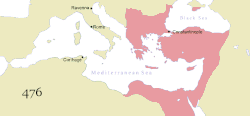
Back الإمبراطورية البيزنطية تحت حكم السلالة الدوكاسية Arabic Βυζαντινή Αυτοκρατορία υπό τη Δυναστεία των Δουκάδων Greek Imperio bizantino bajo la dinastía de los Ducas Spanish Empire byzantin sous les Doukas French Kekaisaran Romawi Timur di bawah Dinasti Doukas ID دوکاس شاہی سلسلہ کے تحت بازنطینی سلطنت Urdu 杜卡斯王朝 WUU 杜卡斯王朝 Chinese
Byzantine Empire
| |
|---|---|
| 1059–1081 | |
 The Byzantine Empire in 1081 before the coronation of Alexios I | |
| Capital | Constantinople |
| Common languages | Greek, Armenian, Aromanian, Old Bulgarian, South Slavic languages |
| Religion | Greek Orthodox Church |
| Government | Bureaucratic semi-elective monarchy |
| Emperor | |
• 1059–1067 | Constantine X Doukas |
• 1071–1078 | Michael VII Doukas |
| History | |
• Abdication of Isaac I Komnenos | 1059 |
• Coronation of Alexios I | 1081 |
| History of the Byzantine Empire |
|---|
 |
| Preceding |
| Early period (330–717) |
| Middle period (717–1204) |
| Late period (1204–1453) |
| Timeline |
| By topic |
|
|

The Byzantine Empire was ruled by emperors of the Doukas dynasty between 1059 and 1081. There are six emperors and co-emperors of this period: the dynasty's founder, Emperor Constantine X Doukas (r. 1059–1067), his brother John Doukas, katepano and later Caesar, Romanos IV Diogenes (r. 1068–1071), Constantine's son Michael VII Doukas (r. 1071–1078), Michael's son and co-emperor Constantine Doukas,[1][2] and finally Nikephoros III Botaneiates (r. 7 January 1078 – 1 April 1081), who claimed descent from the Phokas family.
Under the rule of the Doukids, Byzantium was fighting a losing battle against the Seljuk Turks, losing most of its remaining possessions in Asia Minor following the catastrophic defeat at the Battle of Manzikert in 1071 and the following civil war after the death of Romanos IV Diogenes. Byzantium also incurred substantial loss of territory in the Balkans, to the Serbs, as well as losing its final foothold in Italy, to the Normans.
Although the Crusades gave the empire a temporary respite during the 12th century, it never recovered fully and eventually entered its period of fragmentation and terminal decline under the pressure of the Ottomans in the late medieval period.
In 1077, Alexios Komnenos, then a general, married Irene Doukaina, the great-niece of Constantine X. His marriage to a Doukaina made him senior to his elder brother Isaac, and it was Doukai financial and political support that largely facilitated the successful coup that brought him to the throne.[3]
- ^ Cite error: The named reference
ODB655was invoked but never defined (see the help page). - ^ Cite error: The named reference
EHW5.1was invoked but never defined (see the help page). - ^ Krsmanović 2003, Chapter 5.4.